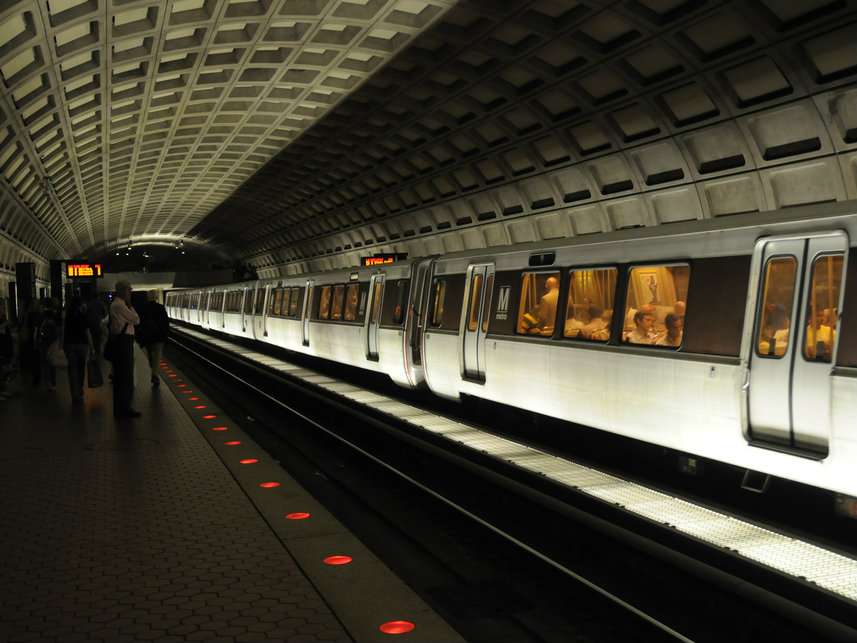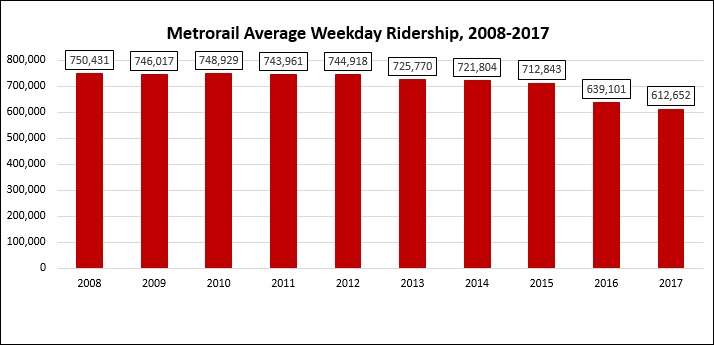D.C.'s Dysfunctional Metro System Is a National Embarrassment
The D.C. Metro has perfected the art of replicating the traffic woes above ground in the tunnels below.

Beginning this week, passengers on the District of Columbia's Metrorail network—the six-line, spontaneous fire-prone train system known here as the D.C. Metro— can expect fare increases and service cuts.
As you might imagine, few in the area are pleased. A few days ago, the Washington Examiner declared that the city's rapid-transit system "is the worst in the world." I'll be generous and not go that far. The D.C. Metro is definitely not the dirtiest system I've ever experienced (I'm looking at you New York City), but the system is hardly a model of success, either. Deferred maintenance, poor planning by the original designers, a dysfunctional governance structure, and general incompetence and negligence on the part of management and staff have taken their toll since its 1976 opening.
All of these problems came to a head in 2009, when a crash near the Fort Totten station in Northeast D.C. killed nine people, including the train's operator, and injured 80. Following the accident, the National Transportation Safety Board (NTSB) released a report that identified failures at almost every level of The Washington Metropolitan Area Transit Authority (WMATA), including actions taken by the train operator, maintenance workers, senior management, and control room operators.
The severity of this incident prompted a $5 billion capital improvement program, with nearly half of the money coming from federal grants. Metro finally had the funds it needed to make significant improvements, but as time dragged on it would become apparent that absent major structural reforms in how the WMATA functioned, that money would not be well spent.
In 2015 another headline-grabbing incident occurred near L'Enfant Plaza, in D.C.'s Southwest quadrant. An electrical malfunction caused a train to get stuck in a smoke-filled tunnel. One woman died and another 86 people were sent to the hospital. With public trust in the system at a new low, ridership dropped significantly.

As someone who has ridden plenty of rapid-transit systems outside of the U.S., I can attest to just how bad the D.C. Metro compares. Having ridden the Shanghai Metro for the past two years while a student at New York University Shanghai, I can recall a train stopping in between stations only once and for ten seconds at most. By contrast, my morning train into downtown D.C. last Friday stopped a total of five times between stations, the longest delay being almost five minutes. And this isn't even that bad comparatively, according to stories I've heard from longtime residents.
Some might gripe that making comparisons between D.C.'s system and those in Asia or even New York's sprawling network are unfair. After all, D.C. is neither as populated nor as dense as Shanghai, Tokyo, or New York. But even taking into account these differences, a lot of the Metro's dysfunction defies logic.
Shanghai's system, for instance, handles far more people and is way more overcrowded than the D.C. Metro. Yet in Shanghai, rush-hour headways—the amount of time between trains on the same track—can be as little as two minutes, with trains moving seamlessly from station to station at full speed. In D.C., the Metro has six minute headways during rush hour—at least on paper—which will soon increase to eight. Yet trains often run behind schedule and frequently have to stop in tunnels for trains in front of them to move.
If people wanted the experience of frequent breaking while crawling to their destination, they could just drive their cars during rush hour. Subways exist to provide public transportation that, unlike a bus, isn't subject to traffic jams. Unfortunately, the D.C. Metro has perfected the art of replicating the traffic woes above ground in the tunnels below. This is despite all the years and additional money the WMATA has had to fix the maintenance problems behind these daily delays.
As I write this, part of the Red Line, the system's busiest, has been shutdown. From mid-May to mid-June, all Orange Line stations in Maryland, as well as some in D.C., were shut down. There are weekends where all six lines are impacted by track work.
At least some of the dysfunction stems from the WMATA's awful work culture. "Consciously or subconsciously, everyone at Metro knows they've got a job for life, unless they sit there and smoke crack in the middle of the platform," a former WMATA mechanic told the Washingtonian in 2015.
Falsified safety inspection reports are rampant—last December, nearly half of the system's track inspection department were facing facing disciplinary action over falsified safety records that came to light after a July 2016 derailment near the East Falls Church Metro station in northern Virginia.
Meanwhile, an employee who falsified inspection-records regarding ventilation fans near L'Enfant Plaza, where the deadly accident in 2015 occurred, may be getting his job back, thanks to the Amalgamated Transit Union Local 689. "The public is safer with [Seyoum] Haile, an experienced, proven, competent mechanic, chastened to ensure accurate records of his work, than with some unknown, untested and likely less skilled mechanic," union lawyers claimed.
An arbitration panel decided that instead of firing him, Haile should get a six-month suspension. The court found in April that Metro didn't meet its legal burdens for overturning the arbitration ruling, even though the judge deciding the case openly admitted that Mr. Haile's termination "may even have been the more just outcome here."
The Amalgamated Transit Union Local 689 is the union that employs a significant majority of WMATA workers. If you read an article recently published in the Washington Post by the union president, Jackie Jeter, you would think the union had nothing to do with the problems at the WMATA. It's demonstrably false.
Jeter, along with other union representatives, has recently been touting the union's plan to fix the WMATA. The plan has some grand ideas, but few well-thought-out ones. The most notable is the call for a $2 flat fare. Not only is this not feasible with the WMATA's current financial situation, but it's terribly misguided. If there's one thing the Metro has going for it, it's the current distance-based pricing system with surge pricing during rush hour. Arguments could be made that fares at all levels are too high, but the fare structure itself is not a problem.
The union decries the current system as "too complicated" and points out that most U.S. rail systems use flat fares. That's actually true, but most major systems in other countries use distance-based pricing and for good reason: flat fares create an incredibly distortionary price environment.
If the fare is set at the highest distanced-based fare, only people with long commutes would use the system. If the fare is set at the lowest distance-based fare, the system wouldn't make any money. What results is a fare that is somewhere in the middle and that's not as good as it sounds. Riders who only go short distances and/or use the system when it's not rush hour end up subsidizing people with long commutes during peak times. Conversely, long and/or rush hour commutes are much cheaper than they should be and people who otherwise might avoid commuting at those hours would be incentivized to do so, further exacerbating overcrowding.
Jeter has been highly critical of WMATA General Manager Paul J. Wiedefeld for "blaming labor costs for Metro's problems," but the fact of the matter is 74 percent of the agency's operating costs are labor-related. To not address that would be foolish. If the agency wants to be able to spend more money on fixing the sorry state of its rail infrastructure, then bloated pensions, excessive overtime payments, and six-figure salaries for some of the agency's employees need to be addressed.
Privatization would be the best idea. In Hong Kong and Tokyo, private companies run clean, efficient systems that don't cost a fortune. These systems, which use distance-based pricing, have farebox recovery ratios—the percentage of operating costs covered by fare revenue—that are far higher than the D.C. Metro. Hong Kong's MTR, in particular, makes a healthy profit just from fare revenue. Contrary to those who claim the WMATA suffers because of a lack of dedicated government funding, reliance on fare revenue actually incentivizes improved service. Until the WMATA's byzantine governance structure is overhauled and its labor contracts rewritten, any revenue promises should be tied to the implementation of major reforms.
Of course, advocates for privatization face a long, uphill battle. The Amalgamated Transit Union certainly would not be on board. "Privatizing Metro can only make our troubled rail system worse," wrote Jeter. As if that were even possible.
Maybe one day our nation's capital will have a Metro to be proud of. One that has on-time trains, a good safety record, and a clean balance sheet. A commuter can dream can't he? Until then, the city that serves as the headquarters of our federal government will, fittingly, have the Metro it deserves: a slow and expensive one.




Show Comments (46)